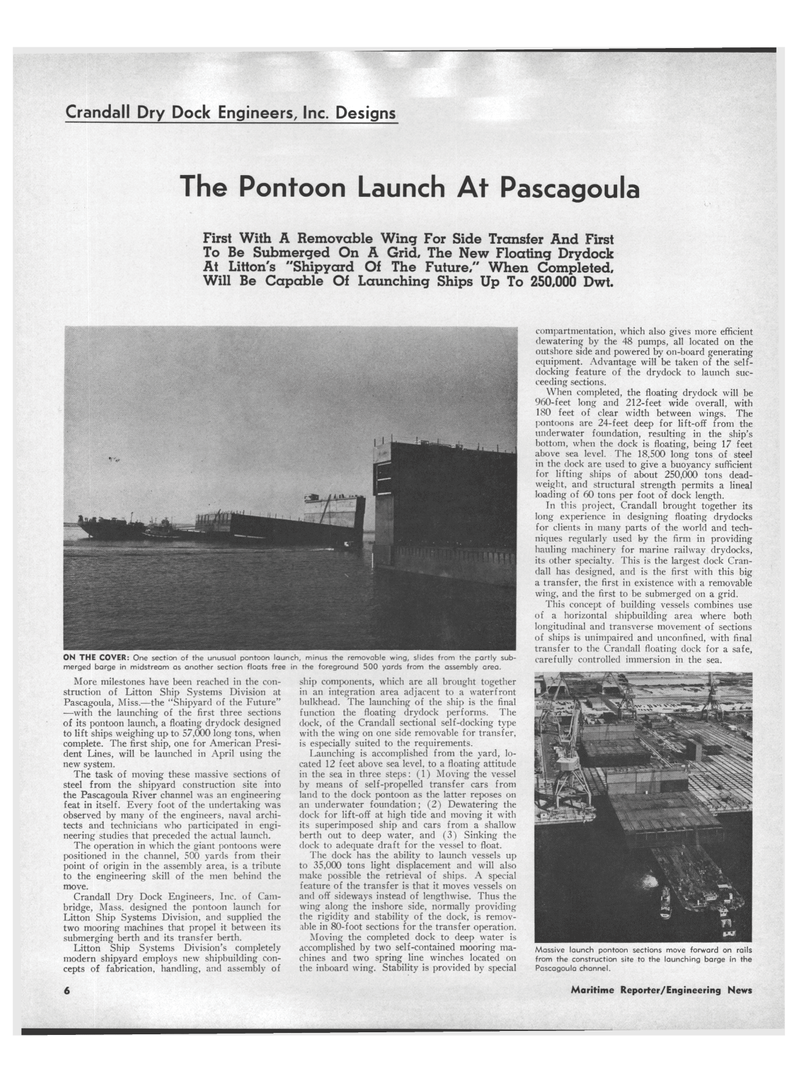
Page 4: of Maritime Reporter Magazine (February 15, 1971)
Read this page in Pdf, Flash or Html5 edition of February 15, 1971 Maritime Reporter Magazine
Crandall Dry Dock Engineers, Inc. Designs
The Pontoon Launch At Pascagoula
First With A Removable Wing For Side Transfer And First
To Be Submerged On A Grid, The New Floating Drydock
At Litton's "Shipyard Of The Future," When Completed,
Will Be Capable Of Launching Ships Up To 250,000 Dwt.
ON THE COVER: One section of the unusual pontoon launch, minus the removable wing, slides from the partly sub- merged barge in midstream as another section floats free in the foreground 500 yards from the assembly area.
More milestones have been reached in the con- struction of Litton Ship Systems Division at
Pascagoula, Miss.—the "Shipyard of the Future" —with the launching of the first three sections of its pontoon launch, a floating drydock designed to lift ships weighing up to 57,000 long tons, when complete. The first ship, one for American Presi- dent Lines, will be launched in April using the new system.
The task of moving these massive sections of steel from the shipyard construction site into the Pascagoula River channel was an engineering feat in itself. Every foot of the undertaking was observed by many of the engineers, naval archi- tects and technicians who participated in engi- neering studies that preceded the actual launch.
The operation in which the giant pontoons were positioned in the channel, 500 yards from their point of origin in the assembly area, is a tribute to the engineering skill of the men behind the move.
Crandall Dry Dock Engineers, Inc. of Cam- bridge, Mass. designed the pontoon launch for
Litton Ship Systems Division, and supplied the two mooring machines that propel it between its submerging berth and its transfer berth.
Litton Ship Systems Division's completely modern shipyard employs new shipbuilding con- cepts of fabrication, handling, and assembly of ship components, which are all brought together in an integration area adjacent to a waterfront bulkhead. The launching of the ship is the final function the floating drydock performs. The dock, of the Crandall sectional self-docking type with the wing on one side removable for transfer, is especially suited to the requirements.
Launching is accomplished from the yard, lo- cated 12 feet above sea level, to a floating attitude in the sea in three steps: (1) Moving the vessel by means of self-propelled transfer cars from land to the dock pontoon as the latter reposes on an underwater foundation; (2) Dewatering the dock for lift-off at high tide and moving it with its superimposed ship and cars from a shallow berth out to deep water, and (3) Sinking the dock to adequate draft for the vessel to float.
The dock has the ability to launch vessels up to 35,000 tons light displacement and will also make possible the retrieval of ships. A special feature of the transfer is that it moves vessels on and off sideways instead of lengthwise. Thus the wing along the inshore side, normally providing the rigidity and stability of the dock, is remov- able in 80-foot sections for the transfer operation.
Moving the completed dock to deep water is accomplished by two self-contained mooring ma- chines and two spring line winches located on the inboard wing. Stability is provided by special compartmentation, which also gives more efficient dewatering by the 48 pumps, all located on the outshore side and powered % on-board generating equipment. Advantage will be taken of the self- docking feature of the drydock to launch suc- ceeding sections.
When completed, the floating drydock will be 960-feet long and 212-feet wide overall, with 180 feet of clear width between wings. The pontoons are 24-feet deep for lift-off from the underwater foundation, resulting in the ship's bottom, when the dock is floating, being 17 feet above sea level. The 18,500 long tons of steel in the clock are used to give a buoyancy sufficient for lifting ships of about 250,000 tons dead- weight, and structural strength permits a lineal loading of 60 tons per foot of dock length.
In this project, Crandall brought together its long experience in designing floating drydocks for clients in many parts of the world and tech- niques regularly used by the firm in providing hauling machinery for marine railway drydocks, its other specialty. This is the largest dock Cran- dall has designed, and is the first with this big a transfer, the first in existence with a removable wing, and the first to be submerged on a grid.
This concept of building vessels combines use of a horizontal shipbuilding area where both longitudinal and transverse movement of sections of ships is unimpaired and unconfined, with final transfer to the Crandall floating dock for a safe, carefully controlled immersion in the sea.
Massive launch pontoon sections move forward on rails from the construction site to the launching barge in the
Pascagoula channel. 6 Maritime Reporter/Engineering News

 3
3

 5
5
